Become confident in your skills!
In today's world, it's more important than ever to be able to defend yourself. If you're looking to improve your firearms skills, developing confidence is a great way to do it. There are many benefits to being confident in firearms training, and it can help you to be more successful in both self-defense and competitive shooting.
Why do you need to be confident?

Confidence is essential for effective firearms training. When you're confident, you're more likely to stay calm under pressure, make good decisions, and shoot accurately. Here are some of the benefits of being confident in firearms training:
- You're more likely to stay calm under pressure. When you're in a stressful situation, confidence can help you to stay calm and focused. This is essential for making good decisions and shooting accurately.
- You're more likely to take action. In a self-defense situation, you may need to take action quickly. Confidence can help you to do this effectively.
- You're more likely to be successful in competitive shooting. Competitive shooting is all about making quick decisions and taking action. Confidence can help you to do this well.
- You're more likely to enjoy firearms training. When you're confident, you're more likely to enjoy firearms training. This is because you'll be less likely to be afraid of the firearm and more likely to focus on your shooting skills.
How to Develop Your Confidence for Firearms Training
Practice regularly. The more you practice, the more confident you'll become. When you practice, focus on making good decisions and shooting accurately. Dryfire practice is a great way to gain confidence in your firearms skills from the comfort of your home.
Set realistic goals. Don't try to do too much too soon. Start with small goals and gradually work your way up. For example, if you're just starting out, your goal might be to hit the target 10 times out of 10 at 10 yards. Once you've met that goal, you can set a new goal of hitting the target 15 times out of 15 at 10 yards. Then maybe start adding some time constraints.
Visualize yourself succeeding. Before you start shooting, visualize yourself hitting your target. This will help you to stay positive and focused. Close your eyes and imagine yourself taking aim, firing the gun, and seeing the bullet hit the target.
Get positive feedback. Come to a class to receive feedback on your shooting. This will help you to identify your strengths and weaknesses. They can also give you tips on how to improve your shooting.
Conclusion
Developing your confidence for firearms training takes time and effort, but it's worth it. By following these tips, you can become a more effective shooter and protect yourself and your loved ones.

